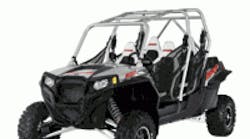For Polaris Industries, Operations is a Competitive Advantage
Polaris Industries Inc. (IW 500/324) a manufacturer of ATVs, snowmobiles, motorcycles and electric powered vehicles, is doing something right. Sales have been climbing back from a low of $1.6 billion in 2009 to $2.7 billion in 2011, with projections of $3 billion in 2012. In fact, the company foresees sales hitting $5 billion in 2018.
What accounts for such optimism? One predominant factor is that the company's largest market, North America, is recovering from a deep recession. "Retail sales in the North American off-road vehicle and motorcycle industries are off to their best start in years," said Polaris CEO Scott Wine in an April 18 earnings release. North American sales increased a healthy 17% in the first quarter, with off-road vehicle sales up 30% and on-road vehicles up 44%.
Overall, sales in the first quarter were at $674 million, up 25% from $537 million in the year-earlier period. Net income grew to $60 million in the three-month period, an increase of 27% from the year-ago quarter.
International markets are also contributing to higher sales. From 2010 to 2011 the company enjoyed a 39% growth rate overseas, with the Asia Pacific region showing the largest gain at 47%.
Mexico Offers Wage Savings, Market Staging Point
Also adding to Polaris' bottom line are improved productivity and better cost controls. The company is quick to point out that "operations is a competitive advantage." Over the past three years productivity has improved 7%.The company realigned its manufacturing operations two years ago into "four centers of excellence" located in Roseau, Minn.; Spirit Lake, Iowa; Osceola, Wis. and Monterrey, Mexico.
The decision to build a plant in Mexico in 2010 to capture lower-wage costs has panned out as the company expects to save $12 million to $15 million in 2012 and eventually see annual savings of $30 million. In its first year of operation the plant produced 22,000 side-by-side vehicles, and it is increasing production in 2012.
"The Mexican location provides lower-cost off-road vehicle production and an efficient distribution platform for penetrating Latin and South American markets to drive future growth," the company said in its 2011 annual report.
Internal improvements are also showing up in better profit margins. "We are realizing the expected savings from our manufacturing realignment project, which provides support to our ongoing margin expansion efforts," said Wine in the April 18 earnings release. For the first quarter of 2012, gross profit margins expanded 60 basis points to 28.9% due to manufacturing realignment savings and lower product and warranty costs.
Other factors affecting overall improvement include managing a flexible workforce that was able to ride through volume swings over the past three years. While shipments were down 29% in 2008, volume has been up 59% for the past two years. And inventory turns increased 18% over the same time period. Innovation is also a contributor to this rosy financial picture.
Research and development has remained steady even when sales were down. The company averaged 4% from 2008 until last year, during which they invested $106 million. A projected 4.5% increase in 2012 will be carried out in technology centers located in Minnesota and Switzerland.
Acquisitions are also helping to fuel Polaris' growth. Last year the company purchased France-based Goupil ?Industrie SA, a manufacturer of on-road, commercial electric vehicles. Prior to this, the company acquired Global Electric Motorcars, a U.S. manufacturer of electric vehicles. "We see tremendous, long-term growth in the global small electric vehicle market," said Wine when the deal was announced.
Polaris officials expect continued growth during the rest of 2012. The company projects that both its retails sales and market share gains will outpace the industry, based on a 10% to 13% increase in sales with net income growth of 20% to 25%.
Caption




